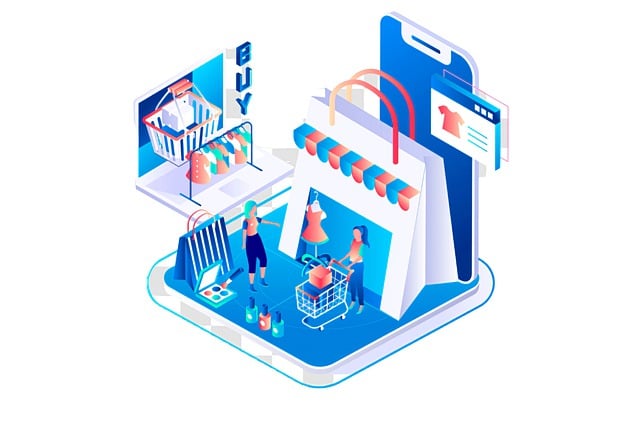Integrating an ecommerce AI Chatbot is a strategic move to enhance customer experience and drive business growth. These chatbots handle inquiries, offer personalized recommendations, and guide shoppers through checkout. Key features include natural language understanding, scalability, and seamless integration with existing systems. Choosing the right platform with NLP and machine learning capabilities is crucial for effective conversational flows. High-quality data training ensures accurate responses to diverse customer needs. Implementing across channels and continuous optimization enhance the ecommerce AI Chatbot's performance and user satisfaction in a dynamic marketplace.
Building an effective eCommerce AI Chatbot is a powerful strategy to enhance customer engagement and sales. This comprehensive guide navigates your journey from understanding unique eCommerce needs to implementing and refining your chatbot. We explore the best AI platforms and technologies, design conversational flows for seamless interactions, and delve into training data methods to power intelligent responses. Discover how to iteratively improve your chatbot, ensuring it becomes a game-changer in providing exceptional customer experiences.
- Understanding Ecommerce AI Chatbot Needs and Goals
- Choosing the Right AI Chatbot Platform and Technology
- Designing Conversational Flows for Effective Interactions
- Training and Feeding Data to Power Your Chatbot
- Implementing, Testing, and Iterating for Continuous Improvement
Understanding Ecommerce AI Chatbot Needs and Goals

In the dynamic landscape of ecommerce, integrating an AI Chatbot can significantly enhance customer experience and drive business growth. The primary goal is often to streamline interactions, providing quick answers to product inquiries, order status updates, and even personalized recommendations. Ecommerce AI Chatbots need to be adept at understanding natural language, navigating complex product catalogs, and offering contextually relevant responses. They must efficiently handle tasks like guiding customers through checkout processes, resolving basic issues, and gathering feedback to improve the overall shopping journey.
Moreover, these chatbots should be designed with scalability in mind, capable of handling a high volume of concurrent users without compromising performance. Integration with existing ecommerce platforms, inventory systems, and customer relationship management (CRM) tools is crucial for providing accurate, up-to-date information. By aligning chatbot development with specific ecommerce goals—be it increasing sales, improving customer satisfaction, or reducing support costs—businesses can harness the power of AI to create a competitive advantage in the digital marketplace.
Choosing the Right AI Chatbot Platform and Technology

When building an Ecommerce AI Chatbot, selecting the right platform and technology is a critical first step. Look for solutions that specialize in conversational AI, offering natural language processing (NLP) capabilities to understand customer queries accurately. Advanced machine learning algorithms are key to improving the chatbot’s performance over time, allowing it to learn from interactions and adapt its responses accordingly.
Popular options include platforms that provide pre-built templates and customization tools, enabling developers to create tailored experiences without extensive coding. These platforms often integrate seamlessly with existing Ecommerce systems, facilitating data exchange for personalized recommendations and order tracking. This ensures a smooth user journey, enhancing customer satisfaction and driving sales.
Designing Conversational Flows for Effective Interactions

Designing effective conversational flows is a key aspect of building an AI chatbot, especially for an ecommerce platform where user interactions are crucial. The goal is to create natural and engaging conversations that guide users towards their desired outcomes, whether it’s making a purchase, finding product information, or receiving personalized recommendations. Ecommerce ai chatbots should be able to handle a wide range of customer inquiries, from simple questions about product availability to complex issues like returns and exchanges.
To achieve this, developers must map out conversation paths that consider various user intents and contexts. This involves defining clear triggers and responses for each potential interaction, ensuring the chatbot can adapt and escalate when necessary. By integrating natural language processing (NLP) capabilities, the chatbot can understand user input, interpret intent, and provide contextually relevant answers. Additionally, incorporating machine learning algorithms allows the chatbot to learn from user interactions, continually improving its performance over time and enhancing the overall customer experience.
Training and Feeding Data to Power Your Chatbot

To power an ecommerce AI chatbot, high-quality data is paramount. Training begins with gathering relevant conversational data, such as customer inquiries and support interactions from your ecommerce platform. This data forms a foundation for teaching the chatbot to understand user queries and respond appropriately. The more diverse and contextually rich the dataset, the better equipped the chatbot will be to handle varying customer needs.
Feeding this data into machine learning algorithms involves careful preprocessing to ensure consistency and accuracy. Text normalization, sentiment analysis, and entity recognition are essential techniques applied to transform raw data into structured inputs. This process enables the chatbot to learn patterns, gain contextual awareness, and deliver precise, relevant responses, enhancing the overall customer experience in ecommerce interactions.
Implementing, Testing, and Iterating for Continuous Improvement

After developing your ecommerce AI chatbot, implementing it on your platform is the next crucial step. Ensure seamless integration across various channels, such as your website, mobile app, or messaging platforms. This involves setting up user interaction flows and defining clear conversational paths to provide a smooth shopping experience.
Testing is essential to ensure the chatbot’s accuracy and effectiveness. Conduct thorough trials with diverse scenarios and user queries. Utilise tools for automated testing and gather feedback from real users to identify areas of improvement. Continuously iterate based on performance data and user feedback, refining the chatbot’s responses, understanding, and overall usability. This ongoing process guarantees that your ecommerce AI chatbot remains optimal, providing enhanced customer service and driving sales in an ever-evolving market.
Building an effective eCommerce AI Chatbot involves a strategic approach from understanding customer needs to continuous improvement. By aligning your chatbot’s goals with your business objectives, choosing the right platform, designing intuitive conversational flows, and rigorously training with relevant data, you can harness the power of AI to enhance customer engagement and drive sales. Regular implementation, testing, and iteration are crucial to refining your chatbot’s performance, ensuring it remains a valuable asset in the competitive world of eCommerce.
